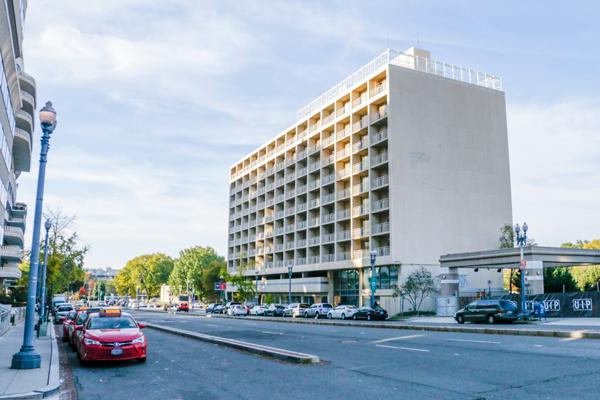The former Hall on Virginia Avenue will become an apartment with a rooftop swimming pool, public ground-level restaurant and 2,000-square-foot fitness center.
Brook Katzen, the vice president of development for Urban Investment Partners that owns the building, detailed plans to renovate the space at the Foggy Bottom and West End Advisory Neighborhood Commission meeting this month. The building will have 250 studio, single bedroom and double bedroom apartments and will be the newest addition to a rapidly booming residential area.
UIP plans to horizontally expand the former residence hall’s existing 110,000 square feet to 145,000 square feet. The new structure, renamed Boathouse, will maintain the current building’s underground parking garage, columns, slab and overall structure, Katzen said.
“Our intention is to maintain the existing structure, completely redevelop it, reskin the building and expand it a little bit,” Katzen said. “When we’re done with it, you won’t even recognize the building.”
UIP would need to petition for a change the building’s zoning with the city government to open commercial businesses, like a 5,000-square-foot ground-level restaurant, within it, Katzen said.
“We’d like to get some outdoor dining outside of the restaurant,” Katzen said. “Hopefully with some big sort of garage doors that kind of open up the inside to the outside so we can have a dining experience with a strong connection between the indoors and the outdoors.”
GW sold the former residence hall to the real estate development firm this year for $36 million. After shutting down the HOVA residence hall in May 2014, GW abandoned plans to renovate and reopen the building to faculty and students. GW listed the property under the representation of the CBRE Group, Inc., after the University had already gutted the interior.
Amenities at the new Boathouse will include technological features, like electronic access to apartments, services compatible with iPhone apps and either Google Home or Alexa technologies that would allow residents to order delivery food or an Uber using their voices. The mezzanine-style second floor will house a library, meeting rooms and a multi-purpose theater, Katzen said.
Other resident-exclusive additions to the Boathouse development will include a bike room in the garage, a pet-washing station, communal kitchens and an undetermined rooftop restaurant.
“Maybe its some kind of juice bar or smoothie bar because we have our fitness center up there and a pool,” Katzen said. “We want to emphasize a healthy lifestyle as part of the concept for this building.”
Katzen said UIP has renovated nearly 30 buildings in D.C., including properties in the Adams Morgan, U Street corridor and Tenleytown neighborhoods.
“What we’re known for, and what I think we’re really good at, is identifying underutilized structures in awesome locations and redeveloping them into class A multi-family residential communities,” Katzen said.
Katzen noted that Boathouse construction will not require extensive noise disruptions because the underground parking garage does not need drilled, which is usually the noisiest part of any construction. UIP will not apply for a liquor license or for live entertainment for the rooftop, which also reduces the risk of noise complaints, he added.
UIP Principal Steve Schwat said the developers plan to market the apartments to young professionals in the area, instead of students. He said UIP predicts Boathouse will attract residents from 25 to 35 years of age who are looking for short-term leases while studying or working in the area.
“This is not Varsity on K, the other building GW sold, which they are really looking to lease to GW students,” he said. “Our building is not really targeted towards a dormitory or student population.”
GW’s lease on the former City Hall residence hall ended last year, and the building was sold for nearly $80 million. The Varsity on K complex is set to open in January.
Schwat, who graduated from GW in 1984, added that the Boathouse’s location next to the Potomac River and Rock Creek Park makes it accessible for outdoor activities, which could be a draw for potential residents.
“So anyone who likes to run, bike, walk their dog or exercise outside, boom you’re right there,” Schwat said. “We see that as a key feature to the building.”







